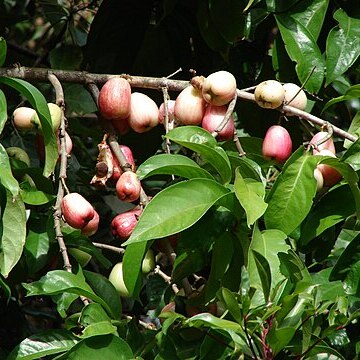Mostly glabrous trees, shrubs or geoxylic subshrubs. Leaves opposite, penninerved, usually with an intramarginal vein. Inflorescences usually terminal and axillary. Flowers solitary and axillary or more usually in cymes or panicles, 4–5-merous; receptacle sometimes prolonged above the ovary and base usually narrowed to form a pseudopedicel above the bracteoles which are usually inconspicuous and deciduous. Calyx-lobes persistent or falling. Petals free or more or less united into a calyptra (in African species). Stamens usually numerous and conspicuous, in several series borne on receptacle rim, free or inconspicuously arranged in 4 obscure bundles; filaments filiform; anthers dehiscing by longitudinal lateral slits. Ovary 2(rarely 3–4)-locular, the locules usually near distal part of ovary; ovules few to numerous in each locule, in crowded subcapitate clusters attached to the central partitions. Style filiform; stigma minute. Fruit a fleshy or dry leathery berry with 1–2 (rarely more) ± large seeds; testa membranous to crustaceous; cotyledons fleshy, usually completely free or partially fused (rarely completely fused).
Usually trees, sometimes shrubs, nearly always glabrous. Lvs opposite, often glandular. Infl. usually terminal, cymose or paniculate, sometimes fls solitary, sometimes cauliflorous; bracteoles mainly inconspicuous and fugaceous; pseudopedicel mostly present. Hypanthium obovoid-clavate, turbinate, obconic or campanulate, sometimes produced beyond ovary; calyx lobes 4-5, often inconspicuous. Petals 4-5, often forming a calyptrum, generally caducous. Stamens numerous, in several to many whorls, free, > petals, much incurved in bud; anthers variable; anther sacs usually parallel. Ovary 2-(3)-celled, with tissue often spongy; ovules few to many; style often long and exserted. Fr. baccate, globular to subcylindric, ellipsoid, obovoid, 1-2-seeded.
Shrubs or trees. Inflorescence usually centrifugal, cymose, more or less panicu-late. Flowers 4-merous. Receptacle produced above the ovary. Sepals persistent, mostly semi-orbiculate, sometimes distinct. Petals free or coherent. Anthers dorsifixed, opening with longitudinal slits. Ovary 2 (-4)-celled, the cells many-ovulate. Berry globose or pear-shaped, often carnose and edible, mostly 1-seeded. Testa adhering to the pericarp. Cotyledons free, carnose; radicle short, hidden between the cotyledons.

